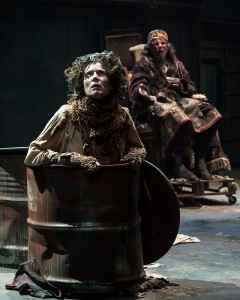Endgame saved by strong performances
“Can there be misery loftier than mine?” If the mindset of the average college student during midterm season were to be translated into a play, it would probably end up looking much like the production of Samuel Beckett’s Endgame currently showing at A Noise Within. Set in a dank, drippy basement with two filthy windows and no furniture or cheeriness to speak of, this play is a 90-minute slug through post-apocalyptic depression.

Nonsensical · Endgame explores life in a post-apocalyptic earth. The theater adaptation is hard to follow for those unfamiliar with the script. – Courtesy of A Noise Within
Those unfamiliar with the work of Irish playwright Samuel Beckett might find the dialogue, tone and execution of Endgame to be jarring and borderline incomprehensible. Those brave theatergoers who have experienced his other bleak works, such as the seminal Waiting for Godot, however, will know what they’re in for: long stretches of silence, much repetition, whip-fast exchanges of dialogue and general existential dreariness.
Written in 1957, Endgame focuses on the blind, physically handicapped Hamm and his caretaker (or servant? or slave?) Clov as they try to survive after an unnamed disaster has befallen Earth. Though the state of the world is never explicitly stated, multiple references to the Earth being “dead” and desolate have apocalyptic implications. While post-apocalyptic films today lament the loss of the Internet and weapons of mass destruction, Clov’s chief concern about the world’s end is that there are no bicycles left. In fact, much of Clov’s dialogue reads as though it could easily be uttered by a trendy eco-friendly vegan hippie living in Los Angeles in 2013, marking Beckett as a granddaddy to the save-the-earth trends that would pop up after his death.
No one illuminates the classics with as much vigor and grace as the artists at A Noise Within in Pasadena. As they have demonstrated before, even the dustiest, most lifeless pieces can become beautiful and interesting again. Never has this been more evident than in their production of Endgame. This play is perhaps the most Beckett-y of them all, but this particular production is the most accessible version of Beckett audiences will be lucky enough to see.
To be honest, the success of this production can be mainly attributed to the theater’s setup and thus the proximity of the audience to the actors. Trying to grasp the concept behind Beckett’s work can often be like riding a high-speed train; fall off, and it’s next to impossible to catch up with it. In fact, maybe the train even left the station three minutes before the audience could even board. This is why being able to sit so close to the actors is vital to enjoying Beckett; once the audience is separated by more than about 10 rows or, God forbid, multiple balconies, it becomes much too easy to let the droning dialogue serve as a lullaby.
It follows, then, that the actors deserve special commendation for staying hyper-engaged themselves throughout the piece. The somehow energetically charged boredom performed by Geoff Elliott as Hamm and Jeremy Rabb as Clov saved the play from the brink of tedium many times over. Elliott’s beautiful, resonant speaking voice, moreover, is sure to send tingles up the spine.
The shuffling gait and quasi-hunchback posture adopted by Rabb’s Clov is a major source of comic relief for much of the production until a tonal shift highlights the fact that these are products of his beaten-down spirit. Similarly, the whiny timbre of his voice at first appears to be an attempt at buoying the audience’s depression with a glimmer of silliness, but it’s slowly revealed that all that remains of Clov’s personality is his negativity.
Another source of partial comic relief is Hamm’s set of parents, named Nagg and Nell (portrayed by Mitchell Edmonds and Jill Hill, respectively), who only ever appear from the waist-up because they live in barrels. (Yes, barrels. They don’t call it Theater of the Absurd for nothing.) Occasionally piping up when summoned by their son, Nagg and Nell provide brief glimpses of Beckett’s sense of humor: “At least our hearing hasn’t failed,” Nagg says. “Our what?” Nell says. But, like Clov, Nagg and Nell turn out to be more dark than comedy.
Apart from having a thought-provoking script and compelling performances from all four actors, the only other aspect of the production worth noting is the clever lighting design. Lighting designer Karyn D. Lawrence employed subtle shifts in white lighting to draw the audience’s attention to different parts of the stage, impressively creating the illusion that the set was more than just a one-room basement. Lawrence also made excellent use of the abundance of dust on the stage and in the costumes, casting lights that caught the shimmering clouds of dust in action.
Though Endgame presents a challenge to most people with 21st-century attention spans, the impressive production at A Noise Within offers a cathartic experience to those students experiencing schoolwork-induced existential crises.
Follow Marianne on Twitter @marianniepants
